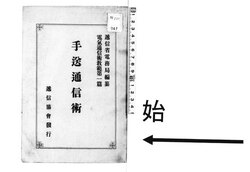File:NDL1055575 手送通信術.pdf

Original file (5,568 × 3,837 pixels, file size: 51.64 MB, MIME type: application/pdf, 97 pages)
Captions
Captions
Summary
[edit]| 手送通信術
( |
|||||||||||||||||||||||||||
|---|---|---|---|---|---|---|---|---|---|---|---|---|---|---|---|---|---|---|---|---|---|---|---|---|---|---|---|
| Author |
逓信省電務局 |
||||||||||||||||||||||||||
| Title |
手送通信術 |
||||||||||||||||||||||||||
| Series title | 電気通信術教範 ; 第1篇 | ||||||||||||||||||||||||||
| Publisher |
逓信協会 |
||||||||||||||||||||||||||
| Language | jpn | ||||||||||||||||||||||||||
| Publication date |
1927 昭和2 |
||||||||||||||||||||||||||
| Place of publication | JP | ||||||||||||||||||||||||||
| Source |
institution QS:P195,Q477675 |
||||||||||||||||||||||||||
| Creator InfoField | 逓信省電務局 編纂 | ||||||||||||||||||||||||||
| Publication Place InfoField | 東京 | ||||||||||||||||||||||||||
| Subject: NDC InfoField | 694 | ||||||||||||||||||||||||||
| Extent InfoField | 173p ; 23cm | ||||||||||||||||||||||||||
| Material Type InfoField | Book | ||||||||||||||||||||||||||
| Source Identifier: JPNO InfoField | 44052172 | ||||||||||||||||||||||||||
| Date Digitized: W3CDTF InfoField | 2010-03-31 | ||||||||||||||||||||||||||
| Audience InfoField | 一般 | ||||||||||||||||||||||||||
| Title Transcription InfoField | シュソウ ツウシンジュツ | ||||||||||||||||||||||||||
| Series Title Transcription InfoField | デンキ ツウシンジュツ キョウハン ; 1 | ||||||||||||||||||||||||||
| Publisher Transcription InfoField | テイシン キョウカイ | ||||||||||||||||||||||||||
| Source Identifier: NDLBibID InfoField | 000000648760 | ||||||||||||||||||||||||||
| Call Number InfoField | 特231-749 | ||||||||||||||||||||||||||
| Creator: NDLNAId InfoField | 00256649 | ||||||||||||||||||||||||||
| Contents InfoField | 標題 第三節 二重受信/170p | ||||||||||||||||||||||||||
Licensing
[edit]This image is in the public domain because it is a mere mechanical scan or photocopy of a public domain original, or – from the available evidence – is so similar to such a scan or photocopy that no copyright protection can be expected to arise. The original itself is in the public domain for the following reason:
This tag is designed for use where there may be a need to assert that any enhancements (eg brightness, contrast, colour-matching, sharpening) are in themselves insufficiently creative to generate a new copyright. It can be used where it is unknown whether any enhancements have been made, as well as when the enhancements are clear but insufficient. For known raw unenhanced scans you can use an appropriate {{PD-old}} tag instead. For usage, see Commons:When to use the PD-scan tag. |
File history
Click on a date/time to view the file as it appeared at that time.
| Date/Time | Thumbnail | Dimensions | User | Comment | |
|---|---|---|---|---|---|
| current | 16:33, 26 November 2023 |  | 5,568 × 3,837, 97 pages (51.64 MB) | Wmr-bot (talk | contribs) | 上載《1055575.pdf》 |
You cannot overwrite this file.
File usage on Commons
The following page uses this file:
Metadata
This file contains additional information such as Exif metadata which may have been added by the digital camera, scanner, or software program used to create or digitize it. If the file has been modified from its original state, some details such as the timestamp may not fully reflect those of the original file. The timestamp is only as accurate as the clock in the camera, and it may be completely wrong.
| Short title | |
|---|---|
| Author | |
| Keywords | https://commons.wikimedia.org/wiki/Commons:Library_back_up_project |
| Conversion program | PyPDF2 |
| Encrypted | yes (print:yes copy:no change:no addNotes:no algorithm:AES-256) |
| Page size | 2673 x 1842 pts |
| Version of PDF format | 1.7 |




